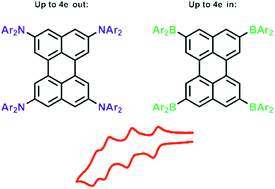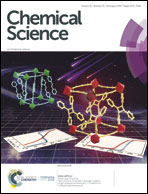Synthesis, photophysical and electronic properties of tetra-donor- or acceptor-substituted ortho-perylenes displaying four reversible oxidations or reductions†
Abstract
Via regioselective Ir-catalyzed C–H borylation and subsequent reactions (i.e., viaBr4-Per or (BF3K)4-Per intermediates), we have introduced strong π-donors and acceptors at the 2,5,8,11-positions of perylene leading to unusual properties. Thus, incorporation of four donor diphenylamine (DPA) or four acceptor Bmes2 (mes = 2,4,6-Me3C6H2) moieties yields novel compounds which can be reversibly oxidized or reduced four times, respectively, an unprecedented behavior for monomeric perylene derivatives. Spectroelectrochemical measurements show NIR absorptions up to 3000 nm for the mono-cation radical of (DPA)4-Per and a strong electronic coupling over the perylene bridge was observed indicative of fully delocalized Robin-Day Class III behavior. Both (DPA)4-Per and (Bmes2)4-Per derivatives possess unusually long intrinsic singlet lifetimes (τ0), e.g., 94 ns for the former one. The compounds are emissive in solution, thin films, and the solid state, with apparent Stokes shifts that are exceptionally large for perylene derivatives. Transient absorption measurements on (DPA)4-Per reveal an additional excited state, with a long lifetime of 500 μs, which sensitizes singlet oxygen effectively.



 Please wait while we load your content...
Please wait while we load your content...